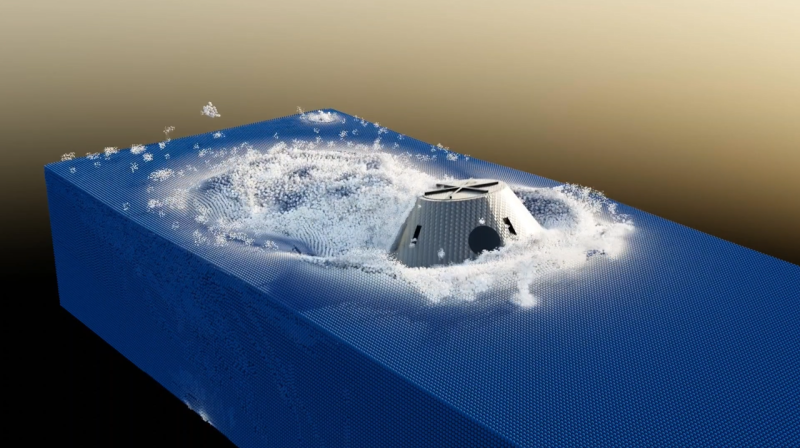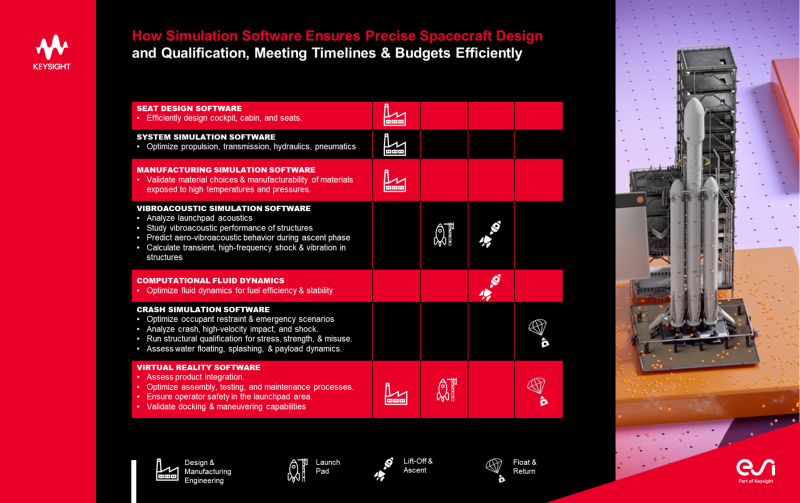Boosting Spacecraft and Astronautical Engineering with (ESI’s) Simulation Software
How simulation accelerates design and qualification processes, ensuring successful tests and missions

Are you curious about how cutting-edge simulation software is transforming spacecraft design? In this blog, we explore the crucial role simulation software plays in revolutionizing spacecraft design and performance. Whether you're developing satellites, crewed missions, or next-gen rockets, you'll discover how virtual testing can help streamline your development process, ensure mission success, and reduce costly physical prototypes. If you're an engineer looking to optimize your spacecraft's structural dynamics, vibration, and acoustic performance, this article will guide you through the benefits of integrating advanced simulation tools into your workflow. Read on to learn more and find registration details about our upcoming webinar program on vibroacoustic simulation software for space engineering.
What is Spacecraft and Aeronautical Engineering?

Orion splashdown simulation in VPS, Copyright ESI Group 2024
The journey to space has always been one of humanity’s most ambitious engineering feats, demanding precision, innovation, and a readiness to tackle complex challenges. When President Kennedy said we chose to go to the moon "not because it is easy, but because it is hard," he captured the relentless pursuit of progress that still drives aerospace engineers today. In the 1960s, every spacecraft, rocket, and satellite was meticulously handcrafted and tested through physical prototyping. The stakes were high, and each mission carried industry firsts.
However, the work field of aeronautical and astronautical engineering has evolved. Today, with the rise of advanced simulation software, engineers no longer need to rely solely on physical testing. By integrating digital models into the design and validation process, spacecraft engineers can streamline development cycles, reduce costs, and, most importantly, ensure mission success. This article delves into the critical role simulation plays in modern spacecraft development and how ESI's software solutions are empowering engineers to overcome the unique challenges of space exploration.
From Physical to Virtual: The Changing Face of Aerospace Design & Engineering
Engineering practices have been transforming, shifting more and more towards 'qualification by analysis'. Simulation technology allows engineers to virtually prototype flight vehicles like spacecraft, rockets, jet engines, and space systems long before they are physically built. This shift from physical to digital prototype qualification minimizes the need for exhaustive physical testing, allowing teams across engineering disciplines to identify potential flaws, analyze different configurations, and simulate real-world conditions with a high degree of accuracy. The result for the aerospace industry? Faster design cycles, fewer physical prototypes, and safer, more reliable flight vehicles.
How to Master Key Requirements in Spacecraft Development with Simulation Software?
1. Spacecraft System Design and Manufacturing Engineering
Every spacecraft is a complex system made up of thousands of individual components, from structural elements to propulsion systems. Validating the design and manufacturing processes of these components is essential to ensure their reliability in space. Using simulation software, engineers can evaluate various manufacturing methods and analyze how materials behave under extreme conditions.
2. Validate Vehicles & Environments on the Launch Pad
Engineers must account for dynamic loads, vibrations, and acoustic challenges that can affect the spacecraft's structure. Simulating the launch environment helps engineers predict how a spacecraft will respond to these conditions and identify any potential weaknesses before the first ignition.
At ESI, we help Space Vehicle Manufacturers, Launch Site Operators, Satellite Manufacturers, and Payload Integrators reduce the complexity, length, and cost of testing new launch vehicles caused by the lack of integrated vibro-acoustic analyses. Our solution, ESI VA One, accelerates iteration cycles by delivering comprehensive, standardized analyses that integrate Ray-Tracing, finite element, statistical energy analysis, and boundary element methods for both payloads and launch vehicles. As the vibro-acoustic simulation tool with the longest legacy in space engineering, VA One sets the industry-standard, enabling you to approach hardware tests with greater, earlier confidence in the accuracy of your test results, ensuring your designs meet space agencies' and customers’ standards the first time.
3. Analyze Flight Dynamics During Lift Off & Ascent
Once a spacecraft is in flight, its behavior is governed by the laws of physics. Engineers must account for fluid dynamics, payload dynamics, and the harsh realities of space, including micrometeorite impacts and re-entry stresses. By using advanced simulation techniques, spacecraft engineers can predict how a vehicle will perform during different phases of the mission.
4. Evaluate Performance During Float and Return of Aviation Systems
Safely returning spacecraft from orbit is another critical aspect of mission success. Engineers must ensure that systems, from heat shields to landing gear, perform as expected during re-entry and splashdown. Simulation software helps assess the performance of spacecraft components during these stages, from flotation devices to crew safety systems.
The Value of ESI’s Simulation Software for Astronautical and Aeronautical Engineering: Win the Space Race
As the space industry moves into a new era of exploration, driven by private companies and international partnerships, the need for efficient and accurate engineering solutions has never been greater. Simulation software empowers engineers to develop high-performance, reliable spacecraft without the need for costly and time-consuming physical prototypes. The ability to predict and validate performance in virtual environments ensures that missions are safer, faster, and more cost-effective.
At ESI, we’ve been pioneering virtual prototyping solutions since the early 1980s, helping industries — from automotive to aerospace — leverage the power of simulation. Our tools enable spacecraft engineers to validate complex systems, reduce reliance on physical testing, and accelerate time-to-launch.
In a Nutshell: What Type of Simulation Software Engineers Work With in Aerospace Development?
The evolution of spacecraft engineering from physical prototypes to virtual simulations marks a significant leap forward for the space industry. With advanced simulation software, engineers can test, validate, and optimize every aspect of spacecraft design and performance—from manufacturing methods to in-flight dynamics—without the need for multiple physical prototypes. This shift is critical in today’s rapidly advancing space exploration efforts, where every launch must be flawless.
| Software Type | Phase | Applications | Benefits |
|---|---|---|---|
| System Simulation Software e.g. SimulationX | Design | Validate material choices for components exposed to high temperatures and pressures. | Ensure durability and reliability of critical components under extreme space conditions. |
| Seat Design Software e.g. VSS | Design | Efficiently design cockpit, cabin, and seats. | Ensure crew safety and comfort. |
| Manufacturing Simulation Software e.g. PAM-Composites, PAM-STAMP, ProCAST | Manufacturing Engineering | Optimize manufacturing methods for high-strength metals, composites, and other advanced materials. | Minimize waste, improve production efficiency, and reduce costly rework during spacecraft fabrication. |
| Vibroacoustic Simulation Software e.g. VA One | Launch Pad |
Analyze launchpad acoustics.
|
Mitigate noise and vibration issues during launch, ensuring spacecraft and crew safety. |
| Study vibroacoustic performance of structures under frequency-based loads. | Ensure structural integrity and performance under intense launch conditions. | ||
| Lift -Off & Ascent | Predict aero-vibroacoustic behavior during lift-off and ascent phase. | Prove reliable spacecraft performance during critical launch phases. | |
| Accurately calculate transient, high-frequency shock & vibration in structures. | Ensure durability and integrity under extreme launch and flight conditions. | ||
| Computational Fluid Dynamics (CFD), e.g. OpenFoam | Lift -Off & Ascent | Optimizing fluid dynamics for fuel efficiency and stability in microgravity environments. | Reduce fuel consumption and enhance spacecraft stability for longer mission durations. |
| Crash Simulation Software, e.g. VPS | Float & Return | Advanced analysis of crash, high-velocity impact (HVI), and shock, diagnose reusable rocket components, while optimizing occupant restraint and emergency scenarios like water ditching. | Improve spacecraft safety & integrity during re-entry, safeguarding both crew and payload. |
| Run structural analyses for stress, strength, and misuse while assessing water floating, splashing, and payload dynamics. | Enhance protection from space debris and improve the durability of spacecraft. | ||
| Virtual Reality Software, e.g. IC.IDO | Design & Manufacturing Engineering | Optimize human-centric design in assembly, testing, and maintenance processes. | Enhance ergonomics, assembly accuracy, and maintenance efficiency, reducing errors in production. |
| Launch Pad | Ensure operator safety in the launchpad area. | Reduce potential risks during launch operations. | |
| Float & Return | Docking and maneuvering capabilities for reusable spacecraft components. | Facilitate safer and more efficient docking procedures, ensuring the successful recovery of spacecraft. |
Table 1: Overview about the type of simulation software, engineers work with in aerospace and astronautical development, (C) ESI Group 2024
Join Our Upcoming Webinar Series Tailored to Rocket and Spacecraft Engineers! Learn How You Can Use Vibroacoustic Simulation to Validate Space Structural Dynamics in Launchpad and Flight Dynamics
Calling all Acoustic Engineers in the Space Industry: Join our technical webinar series dedicated to acoustic analysis in space. We're kicking off with Low Frequency Acoustic Analysis with VA One: Accurate Pre-Test Analysis in Aerospace Engineering Using FEM-BEM. Gain insights into the advanced acoustic simulation techniques trusted by industry leaders.
Get more information and register!
Dott. Ing. Massimiliano Calloni is the Senior Product Marketing Manager for ESI Group, where he plays a pivotal role in shaping the future of vibro-acoustic simulation technology. With a Master’s degree in Aerospace Engineering from the prestigious Politecnico di Milano, Massimiliano brings over two decades of deep expertise in Noise & Vibration. His career includes six years at AgustaWestland Helicopters, where he excelled as a consultant in both testing and simulation. Today, he leverages his extensive technical knowledge and marketing acumen to drive the global success of ESI’s VA One software, supporting strategic initiatives worldwide.

